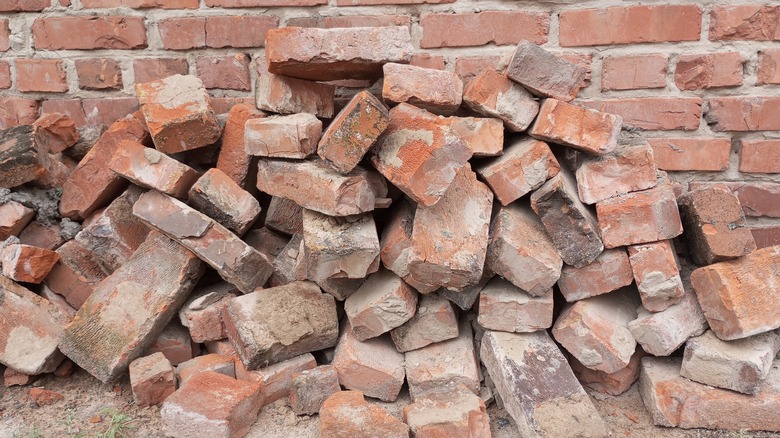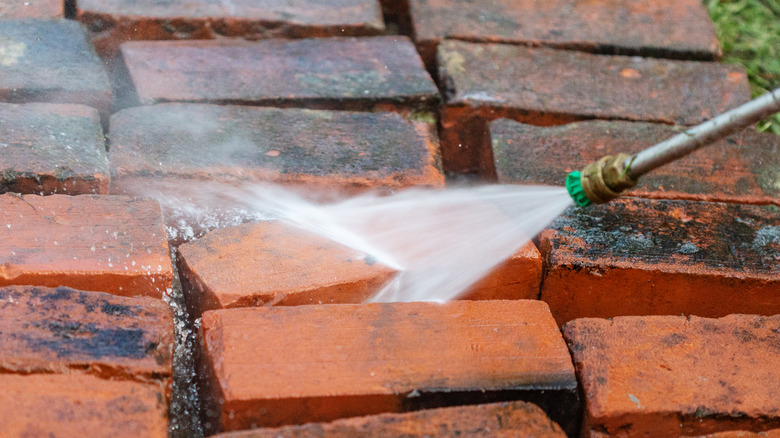How To Easily Clean & Remove Mortar To Reuse Old Bricks
We may receive a commission on purchases made from links.
Coming across a pile of old bricks is a boon for DIYers. The possibilities for reuse are nearly endless, from creating a cute cobbled path through your cottage garden to repurposing old bricks into beautiful light up patio decor. The downside to recycling vintage bricks is that they're often marred by unwanted additions. While you don't want to get rid of that authentic patina, you have to remove caked-on mortar, dirt, mold or mildew, and general staining. Thankfully, renewing old bricks is easier than you think. For mortar, you simply smash it off with a hammer. Muriatic acid diluted in water works wonders for stains of all kinds, just be sure to take the appropriate safety precautions if you decide to use it.
Completing the rather tedious task of removing the mortar is, somewhat unfortunately, essential. If you tried to lay the lumpy-bumpy old bricks as is, you'd potentially end up with a very wonky wall. What's more, the wall might not even stay put once it's up, since new mortar doesn't stick very well to old, dried and cured mortar. Then there's the consideration of whether or not you should upcycle bricks in the first place. Some professional building organizations warn against their use in large-scale or municipal construction projects without thorough strength testing — according to a 2020 paper published in Developments in the Built Environment, the compressive strength of reclaimed bricks ranges anywhere between 4.8% to 40%. This level of testing is difficult for the average DIYer to do. However, they're almost certainly fine to use in small home renovation projects like raised garden beds or paved patios.
Removing mortar by chipping away at it with your tool of choice
You'll need a hammer, cold chisel, hatchet, axe, trowel, or even just a piece of metal for removing the mortar. If you prefer to work even quicker, get your hands on a pneumatic hammer drill fitted with a chisel bit. For bigger or ongoing jobs, you might even want to rent or invest in specialist motorized equipment, like a scraping machine or vibrating plates. Lime mortar comes off easier than its cement-based counterpart so if you know your bricks have the former, you can probably get away with using a simple hand-held tool instead of a power tool. A stiff bristled brush or a wire brush will come in handy, too. Finally, don't forget to don some gloves and safety goggles.
The best way to clean brick patio pavers is by chipping off the mortar. Pick up a brick, identify the largest chunk of mortar, and hit it with the sharp or hitting edge of your implement of choice. (If you're using a hammer drill, set the selector to the hammer-only setting.) All going well, the mortar will dislodge, and you can move on to the next chunk. Some pieces might take more than one whack. Once the biggest chunks have been removed, place the brick somewhere flat and use your tool to scrape the remaining mortar from the surface, holding the brick in one (gloved) hand to keep it sturdy. Work on one side of the brick at a time until you've completed all sides. Lastly, brush off dust with a stiff-bristle or wire brush.
Use muriatic acid to clean old bricks and remove stubborn stains
With the mortar gone, you can assess the condition of the bricks' surfaces. If you spot stains, the bricks will need a good cleaning. Vinegar is sometimes recommended as a brick cleaning agent. It is, for example, a natural ingredient that'll take care of moss growing on bricks. You could certainly try this method for light blemishing. Muriatic acid diluted in water is, however, the go-to solution for professional bricklayers for good reason — it works really well, it's inexpensive, and you can find it at most hardware stores and big box retailers. For example, Walmart sells 1-gallon bottles of Klean Strip green muriatic acid for just under $12.
Personal safety is extremely important when working with muriatic acid. With gloves, goggles, a long sleeved shirt, and long pants on, pour the acid into the water (never vice versa) at a ratio between 1:3 or 1:10 muriatic acid to water, or per the manufacturer's instructions. Place your bricks into the solution, and leave them for up to 20 minutes. Rinse them in fresh water, scrubbing them at the same time. Air-dry the bricks, then check them over carefully to decide whether you need to repeat the cleaning process. You can also spray the solution onto each side of the brick using a garden sprayer. If you find it too difficult to remove the mortar from your bricks, you can also use muriatic acid or another acidic brick cleaning solution like Prosoco Sure Klean 600 — Sunshine Supply in California sells 1-gallon bottles for just under $20 — to soften the material before chipping it off.

